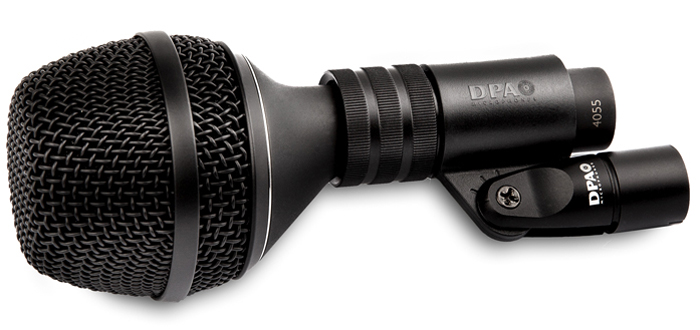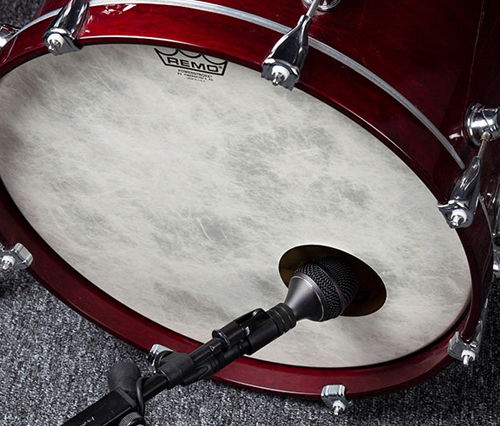
Barry's Mix Magazine Equipment And Software Reviews
Barry's Massive Discography And Engineering Career
Barry's Music Connection Magazine Reviews
Barry's Resolution Magazine Reviews
DPA 4055 Condenser Kick Drum Microphone
Versatile Small-Diaphragm Condenser Can Handle the SPL
By Barry Rudolph
 |
| DPA 4055 Condenser Kick Drum Microphone |
The DPA 4055 Kick Drum Mic is a pre-polarized condenser model and the latest addition to DPA's instrument microphone line. Unlike other kick drum mics, the 4055 has no preset frequency response, curve or shape that the manufacturer thinks best for recording kick drums. It has an open cardioid pickup pattern and a 20Hz to 20 kHz frequency response, with an effective range (+/-2 dB) from 40 Hz to 18 kHz.
The DPA 4055's remarkably flat frequency response curve has only a slight boost, starting at 8 kHz and extending out to about 12 kHz. Its phase response specification looks like one of DPA's measurement microphones. Maximum SPL is 164 dB SPL (peak), and the dynamic range is 132 dB. Sensitivity is measured at 2 mV/Pa, -54 dB re. 1 V/Pa and distortion, THD <1% at 156 dB SPL.
Inside the mic is a miniature, transformerless, active surface mounted electronics on just a sliver of a printed circuit board that fits into the shaft of the mic. The DPA 4055 requires 2.0 mA of current from your +48-volt phantom power and has a rated output impedance of 380 ohms. The active electronics allow the mic to drive up to a 100-meter mic cable, making it perfect for both stages and studios.
The 4055's capsule is internally shock-mounted and comes with the UA0961 locking mic clip. I like the design of this mic clip--when tightened, it grasps the mic's body solidly and equally on all sides. I could place the mic at any height or angle and know that it would never fall out. The mic measures 132 mm (5.19 inches) in length and comes in a matte black finish with a two-part grille (removable for cleaning).
This is the first mic I've seen with an asymmetrical design. The 57 mm (2.2-inch) diameter of the grille is offset to the mic's shaft to be more inline with the centerline of the clip and the mic boom's arm, which I use to mic kick drums. Compared to other kick drum mics, the overall size of the DPA 4055 and its clip makes it easier to fit through the front hole of a kick drumhead and freely position it anywhere inside to capture the exact tone you desire.
 |
| Using the clip, the DPA 4055 can be moved easily inside or outside the kick. |
IN THE STUDIO
For my test, I called in drummer/producer Charlie Waymire to help with the evaluation. We recorded with two different kick drums, using a transformerless input in his Trident 88 console. We put the mic in four typically used positions, on two different-sized bass drums within his kit. We tried both his 24 x 14 and 20 x 14-inch Ludwig drums, each of which had round holes cut in the front head. The front head was a Remo Smooth White Powerstroke 4, and the other head was a Powerstroke 3.
Position 1: We placed the DPA 4055 right on top of the sandbags lying inside the drum, with the mic aimed at the beater. This is an old trick popular for live sound--you use one less mic stand! The 24-inch drum produced a higher-pitch sound that was distinctly heard separate from the bass and clearly stood out in the mix. Position 1 was better on the smaller 20-inch drum and actually bigger-sounding, with more low frequencies. Go figure!
Position 2: We tried a more conventional location, inside the drum, slightly off-center on a short boom stand and aimed at the beater. Both drums sounded good here, with the 20-inch having a much drier sound and the 24 being brighter, livelier and reminiscent of many drum kit recordings I've done.
Position 3: This was our favorite for both drums. The mic was on a short boom stand through the hole and about two inches into the drum--not as deep as Position 2. There was a little more leakage from the rest of the kit and a loud nearby guitar amp in the room, but I liked the balance, ambience and proximal punchy sound that the mic gave us in this position.
Position 4: We placed the 4055 out in front of the kick drum about two or three inches away from the front head, and it was exceptionally good for the larger 24-inch drum. This position captured the most subsonic energy, and there was plenty to work with later in the mix. The increased leakage from the rest of the kit and the room was acceptable because it fit the song's genre.
Having the freedom to experiment with a kick drum mic that would always stay in any position I wanted, without worry of it overloading, allowed us to capture new and interesting tonalities. All four positions produced acceptable and predictable kick drum sounds without any EQ or compression. I liked that the DPA 4055 gave a flat, non-distorted, honest pickup of high-SPL sound that's ready to be "carved" into shape later, if needed.
NOT JUST FOR KICKS
With the 4055 being a nearly "ruler-flat," small diaphragm condenser microphone, I had to try it on other instruments. On acoustic guitar, it required a little more gain than the SDC I usually use, but the results were solid. Using my Mäag Audio PreEQ2 with the +25dB gain position switched in, it sounded clear and ready for EQ and/or compression in the mix.
I'm thrilled that I got a look at the DPA 4055! It has become my utility "use on everything" mic because it is built well, it's rugged and it takes loud levels with no problem. Invest in one for your mic locker!
|
|
|
|
|